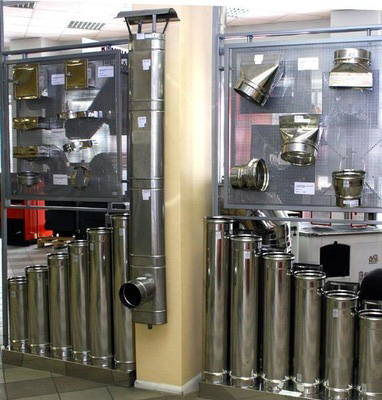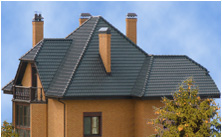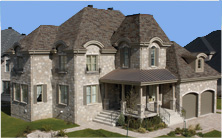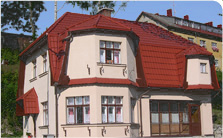The ideal chimney
The ideal chimney
 The main functions of the chimney clear not only to professional builders, but also simple townsfolk. The chimney should be effectively put out of the smoke and other combustion gases from fireplaces and heating appliances using solid fuel, gas or oil.
The main functions of the chimney clear not only to professional builders, but also simple townsfolk. The chimney should be effectively put out of the smoke and other combustion gases from fireplaces and heating appliances using solid fuel, gas or oil.
About how to be a chimney , you need to decide at the design stage of the building. This is important because the material from which the chimney is made, its structure, size and height affect the operation of connected equipment. The building may be provided in one or more flues - often it depends on the architectural features of the object. Usually in one chimney immediately arrange everything necessary for its operation channels - vapor, chimney and venting. However, any of these channels may be set aside in a separate chimney. That is characterized by: the one and the other solution is correct, the main thing - considering that each heated and ventilated room should have its own separate vapor and air ducts.
Task chimney channels, as you might guess from the title, is the removal of smoke from fireplaces, boilers, solid fuel or coal stoves. The diameter of the channel depends on the type and capacity of equipment used, type of chimney and its height. By the arrangement of vertical flue must be approached with great responsibility. The main task - to achieve the proper speed removal of smoke. He should not have time to cool down the chimney.
Exhaust ducts derive products of combustion from the oil cooler and gas installations. Their diameter depends on the estimated number of products of combustion, the difference in temperature and air temperature on the street, the height of the chimney, as well as the total number and capacity of heaters. Ventilation channels Exhaust air from the premises. They must be conducted in rooms where there are no windows (bathrooms, attics, basements). Diameter ducts experts determine, based on data on the estimated amount of exhaust air, the height of the channel, a temperature difference of indoor and outdoor use. The minimum diameter of the ventilation duct should be 0.0016 square meters. m and not less than 11 cm
Chimney height:
- for chimney channels - at least 4 meters (the distance from the source to the outlet above the roof);
- for exhaust ducts - at least 2 meters for gas and 4 m for oil boilers (the distance from the junction with the heater outlet pipe to the outlet above the roof);
- for ventilation ducts - at least 2 meters (the distance from the inlet vent to the outlet above the roof).
What should be the chimney?
- It is best to install the chimney inside the building. But if for some reason, the chimney still posted outside, you must carefully isolate it.
- Height and diameter of the chimney shall be designed by a qualified technician. This is a very important stage, there is no room for error. Remember: too wide chimney reduces the efficiency of the heater, and too narrow - difficult removal of combustion products.
- The location of vertical flue - is strictly vertical. The maximum deviation of - 30 degrees on a segment no longer than 2 meters.
- Canal, which connects the boiler to the chimney should be short, with a minimum number of bends. If such a channel is positioned horizontally, its length should not exceed 2 m and have a slope of 5% in the direction of the heater.
- Over its entire height channels must have the same diameter.
- The diameter of the gas and chimney channels determine, based on the capacity of heating equipment.
- Channels should be made as tight as they tend to spend a short distance from each other. Their cross-country must provide unobstructed drainage out of products of combustion or exhaust air.
- Each heating devices must be connected to individual flue duct. In no case can not connect multiple devices to a single channel.
- The chimney should rise above the roof to the altitude at which will be provided with good traction. The height depends on the degree of slope inclination and used roofing, which is known to classify flammable (wood shingles, straw) and flame (ceramic and cement tiles, metal, asphalt roofing).
- Outlet of a chimney on the slope, which has angle less than 12 degrees, or on a roof covered with flammable material, shall be kept at a height of at least 60 cm above the ridge.
- The outlets of channels can be located at a height of 30 cm above the ridge, when we are dealing with a roof covered with inflammable material, as well as on the slopes with a gradient above 12 degrees.
- In the chimney channel should be provided with suitable traction that will effectively remove combustion products outside. In case of insufficient traction smoke will just go back to the room. Excessive thirst, by contrast, will accelerate combustion.
- To provide traction as needed insulation flue. High-quality insulation will not allow the combustion products ahead of time to cool down, which means that they freely leave the chimney. Also, insulation will not accumulate in the chimney condensation.
- Material from which made chimney must be resistant to high temperatures, moisture and corrosion.
- Chimney on a mandatory basis should be equipped with a reservoir, collecting the condensate, as well as auditing the holes to help remove accumulated soot. Such holes are usually at the bottom of the chimney and it "breaks".
Choose the type of chimney
Steel chimneys are made from high quality, resistant to corrosion and acid steel. May be single-or double-walled. Single wall chimney, in fact, a liner into the existing chimney. In addition, the products of this type can be used to repair existing chimney channel. Such chimneys are designed primarily for efficient removal of combustion products from oil and gas heating boilers, but can also be used for installations of solid fuel.
Double-wall steel chimneys often mounted outside the building - as a freestanding or wall-attached structures. For residential private homes characterized by near-wall system, and freestanding chimneys are usually for industrial facilities. These chimneys consist of two loops - the outer wall has a purely defensive function (protects the chimney from the effects of adverse weather conditions), and the inner wall is designed to remove products of combustion. Between these two circuits is a layer of thermal insulation of mineral wool. Double-wall steel chimneys are applicable to most heating systems.
Ceramic chimneys do not enjoy such popularity as steel counterparts, despite the fact that they are no less efficiently and effectively. Ceramic tube is also often used as a liner into the existing chimney. In addition, many manufacturers offer consumers integrated ceramic system requiring no additional finishing. Such products after assembly are ready chimney. Ceramic chimneys are composed of several loops - an inner ceramic tube, heat-insulating layer and the outer contour of a porous white concrete. Such systems are designed to work with boilers and heating installations using solid fuels, gas or oil.
Remember that the chimney is a stationary system, and therefore it must be mounted so that the time for him to be connected to other, more modern heating installation, because their life is known to be more succinct than the entire chimney. When replacing a heating system chimney also needs to adapt to new conditions of work, unless, of course, its technical condition allows it.
Part of the chimney, which is located above the roof, mostly clinker brick veneer. Also, for lining the chimney can be used in plaster, concrete, ceramic tiles or a full-bodied hollow bricks. Smoke and exhaust ducts are mounted vertically, as in ventilation ducts leave a special side openings. Exit gas operated channels cover the so-called cap of reinforced concrete, with eaves and openings for the smoke. In the regions, which are characterized by a strong wind at the top of the chimney set the nozzle-deflector (vetrovik). It prevents the penetration of smoke back into the flue and a violation of thrust.
Attachment to the chimney are:
- Rotary - nozzles, using wind power to maintain chimney draft. Its turbine always rotates in one direction, regardless of wind direction and force, forming a low pressure in the exhaust duct;
- stationary - nozzles installed in a certain direction. Designed to hide the outlets chimney channel.
Before the commissioning of the chimney should be inspected once a specialist. Necessary to verify the work done with the original project, compliance with the materials used in technical documentation, verify the overall technical condition, the patency of all channels, Chimney cravings ... In the operation of the chimney should be cleaned periodically: two times a year to clean the gas-escape channels, and 4 times a year - chimney.
Source: www.e-dach.com.ua





